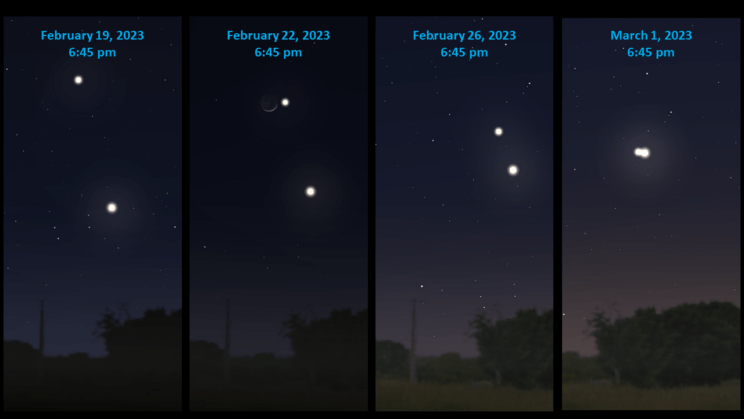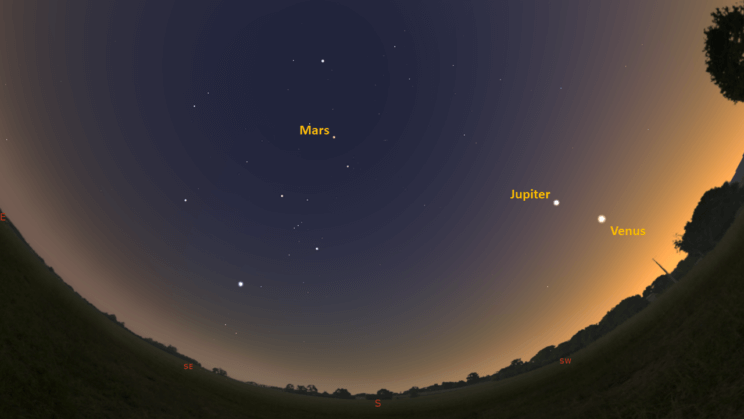This is the Saint Louis Science Center’s NIGHT SKY UPDATE for the week of Friday, February 17, 2023.
Information updated weekly or as needed.
Times given as local St. Louis time which is Central Standard Time (CST). For definitions of terminology used in the night sky update, click the highlighted text. If relying on times posted in Universal Time (UT), St. louis is -6 hours when CST.
Public Telescope Viewings
As part of the Saint Louis Science Center’s First Fridays, weather permitting, the St. Louis Astronomical Society and the Science Center will set up a number of telescopes outdoors and be on-hand to answer your questions. Telescope viewing begins once it is dark. Regardless of the weather on March 3, join us indoors in our planetarium theater for “The Sky Tonight”. Showtime is at 7 p.m.
Observing Highlight of the Week

Jupiter and Venus will reach conjunction and appulse on March 1/2, 2023. Venus is the planet lower to the horizon this week. After March 1, 2023, Jupiter will be the lower planet. Image created using Stellarium.
The highlight for this week is the planet Jupiter. The current apparition of Jupiter is coming to an end. Jupiter reaches solar conjunction on April 11, 2023. As we approach this date, Jupiter will appear closer to the Sun each day until Jupiter is lost to the Sun’s glare. That said, we still have Jupiter highlights to look forward to before this apparition ends.
Jupiter is always an interesting planet to follow. Whether it be through a telescope or through the missions that study Jupiter. Sometime in April, ESA has planned to launch a mission called JUICE. This is ESA’s probe designed to study Jupiter and the three icy moons Ganymede, Callisto and Europa. These moons are thought to have subsurface oceans of liquid water. It will make 35 flybys of these moons before orbiting the largest moon named Ganymede.
NASA’s Juno mission will continue to study the Jovian system until September 2025 or until the spacecraft’s end of life. Juno is now in its extended mission which will have the spacecraft study Jupiter, its rings and moons. You can learn more about the Juno mission here.
Recently, 12 new moons of Jupiter were confirmed, bringing Jupiter’s moon count to 92. All the new moons discovered are smalls moons that take more than 340 days to orbit Jupiter. 9 of these moons are in retrograde orbits meaning they orbit the opposite direction of the inner moons. These were likely captured by Jupiter. The other three have prograde orbits and are believed to have formed in place. You can learn more about these moons here.
For those wanting to see Jupiter, it still makes a fine target in the early evening. Visible in the west after sunset, Jupiter will remain visible until roughly 8:00 p.m. After this time depending on your horizon, trees and buildings may obscure your view. Jupiter sets around 8:54 p.m. and each week later it will set about 20 minutes earlier.
Most binoculars will reveal Jupiter’s Galilean moons. I have seen them in as small as 6×30 binoculars, but it is best to use larger sizes such as 10×50. Details in the atmosphere of Jupiter are visible through most telescopes. Because Jupiter only takes 10 hours to rotate once, every other night usually offers an opportunity to spot Jupiter’s famed Great Red Spot (GRE). Due to its early set times, there is a smaller window of time to catch the GRE, but February 20 and 22 appear to have GRE transits around 7:00 p.m.
If you do not have binoculars or a telescope, on March 1 and 2, Jupiter and Venus will make a tight pair in the sky. These two planets will appear closest together on March 1, 2023, appearing for some only 29.4 arcminutes apart. Unfortunately, Jupiter and Venus will have set by the time the appulse occurs, but they will still be close together when we see them just after sunset.
March 2, 2023, Jupiter and Venus will be in conjunction. This is when they have the same right ascension. The time of conjunction occurs during daylight hours in St. Louis, but again they will make for a nice pair once it is dark outside after sunset.
As we approach these two dates, each night Jupiter and Venus will appear closer together. Currently, Jupiter and Venus appear around 11° apart. They will close that gap in just over two weeks as Venus passes by Jupiter at the start of March. An easy way to track this will be to go outside 20 minutes after sunset and estimate the distance between them with your hand. One fist width held at arm’s length with one eye open is roughly 10° of sky. If you measure this each night, you should notice the separation between them decreasing each night.
The Sun and Moon

The Moon as seen from the International Space Station, on July 31, 2011.
Credit: NASA
Sunrise is at 6:49 a.m. on Friday, February 17 and sunset is at 5:41 p.m. providing us with roughly 11 hours of daylight. Even after sunset, light from the Sun will dimly illuminate our sky for roughly 1 hour and 30 minutes. This period is called twilight, which ends around 7:10 p.m. this week. For those with a sundial, local noon occurs around 12:14 p.m. this week.
| Day | Sunrise | Sunset | ||||||||||
|---|---|---|---|---|---|---|---|---|---|---|---|---|
| 17-Feb | 6:49 a.m. | 5:41 p.m. | ||||||||||
| 18-Feb | 6:48 a.m. | 5:42 p.m. | ||||||||||
| 19-Feb | 6:47 a.m. | 5:43 p.m. | ||||||||||
| 20-Feb | 6:45 a.m. | 5:44 p.m. | ||||||||||
| 21-Feb | 6:44 a.m. | 5:45 p.m. | ||||||||||
| 22-Feb | 6:43 a.m. | 5:46 p.m. | ||||||||||
| 23-Feb | 6:41 a.m. | 5:47 p.m. | ||||||||||
| 24-Feb | 6:40 a.m. | 5:48 p.m. | ||||||||||
| 25-Feb | 6:39 a.m. | 5:49 p.m. |
Moon
Moonrise for Friday, February 17 was at 5:12 a.m. and moonset occurred at 2:26 p.m. Friday, February 17, the Moon will exhibit a waning crescent phase with 8% of the lunar disk illuminated. New moon occurs on February 20, 2023, at 1:06 a.m.
International Space Station (ISS) Observing

There are several visible passes of ISS from St. Louis for the week of February 17. They occur during morning hours. The best passes for this week are listed below. Use the table below for information about these passes.
Catch ISS from St. Louis starting Friday, February 17
| Date | Starts | Max. altitude | Ends | |||||||
|---|---|---|---|---|---|---|---|---|---|---|
| Time | Alt. | Az. | Time | Alt. | Az. | Time | Alt. | Az. | ||
| 20 Feb | -3.2 | 5:37:21 | 28 | W | 5:38:31 | 40 | NNW | 5:41:42 | 10 | NE |
| 21 Feb | -2.5 | 4:50:57 | 37 | NE | 4:50:57 | 37 | NE | 4:53:08 | 10 | NE |
Magnitude (Mag): The Measure of brightness for a celestial object. The lower the value is, the brighter the object will be.
Altitude (Alt): The angle of a celestial object measured upwards from the observer’s horizon.
Azimuth (Az): The direction of a celestial object, measured clockwise from an observer’s location with north being 0°, east being 90°, south being 180° and west being 270°.
For information about ISS flyovers and other visible satellites, visit www.heavens-above.com
Detailed information regarding all unmanned exploration of our universe, missions past, present, and planned, can be found at Jet Propulsion Laboratories:
The Visible Planets

Looking south at 6:40 p.m. on February 18, 2023. Credit: Stellarium, EG
This week, three naked eye planets are visible. Venus and Jupiter are found in the southwest after sunset. Mars is found overhead after sunset.
Venus
Venus is climbing out of the Sun’s glare as it starts another an evening apparition. Once high enough above the horizon, Venus will be a bright target in the west after sunset until August 2023 when it approaches inferior conjunction. This week, look for Venus in the southwest about 20 minutes after sunset. Venus sets at 7:53 p.m.
Mars
Mars now rises before sunset becoming visible once it is dark. Look for it overhead about 30 minutes after sunset. Mars sets by 2:32 a.m.
Jupiter
Now past opposition, Jupiter will be visible about 30 minutes after sunset. Jupiter reaches superior conjunction on April 11, 2023. As we progress towards this date, we will see Jupiter slowly wander towards the Sun. Jupiter now sets at 8:54 p.m.
James S. McDonnell Planetarium
Night Sky Update: February 17 – 25, 2023






